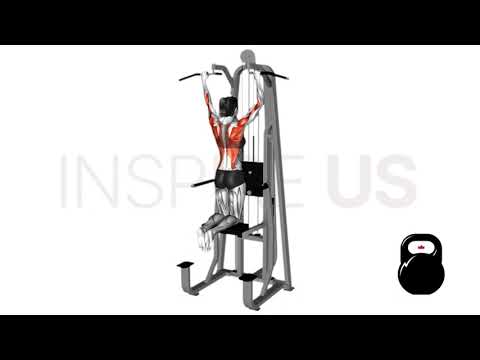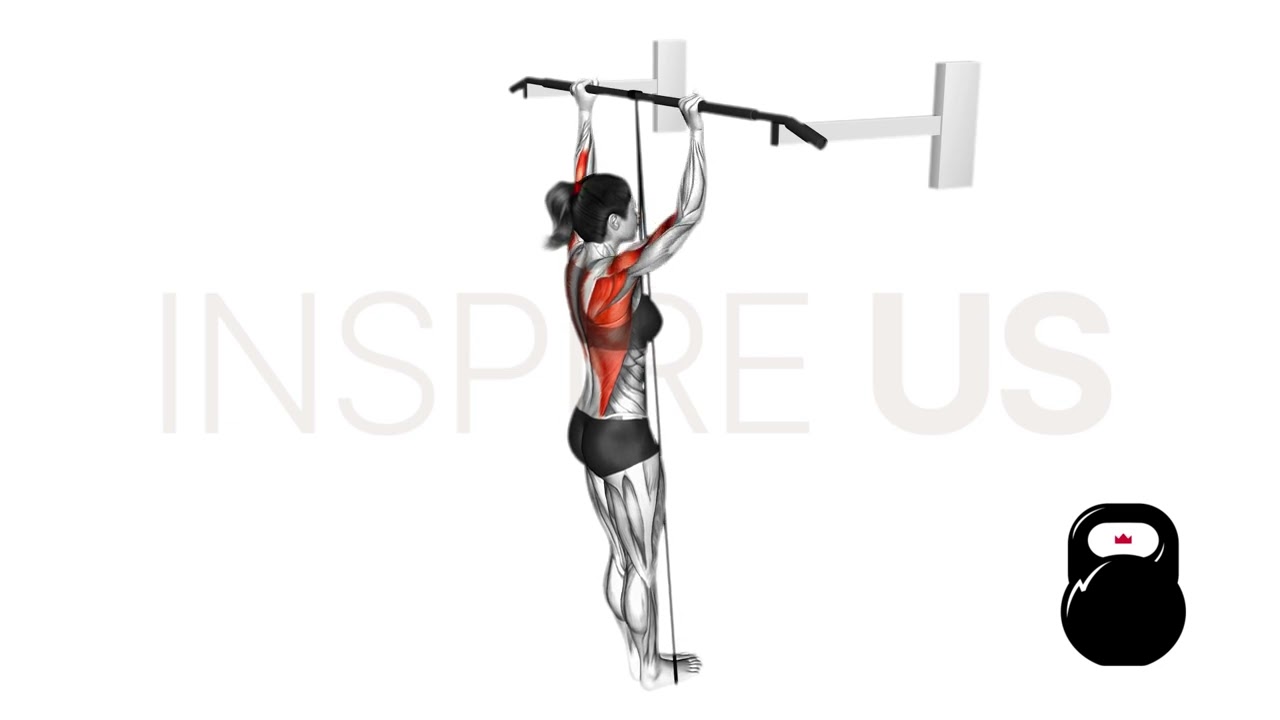Assisted Pull-Up (Band and Machine): Benefits, Muscles Worked, and More
Pull-ups are as iconic a bodyweight exercise as they are difficult. Fortunately, if you can’t quite perform them just yet, there is an alternative that lets you build up the strength needed to do so.
Assisted pull-ups are exactly as they sound; conventional pull-ups performed with the assistance of some sort of counter resistance.
Utilizing assistive counter-resistance reduces how much of your own weight is lifted with each repetition, making the pull-up accessible to even complete novices.
In this article, we will discuss the intricacies of both versions of the assisted pull-up exercise (machine and band assisted), as well as how to get the most out of this excellent pull-up progression tool.
What is an Assisted Pull-Up?
The assisted pull-up (regardless of variation) is a closed chain compound exercise of low or moderate intensity. Although classified as a calisthenics movement, it requires the usage of additional equipment and as such may not be strictly considered a solely bodyweight exercise.

The assisted pull-up is generally performed with the use of a machine specifically designed for making pull-ups easier. However, individuals without access to an assisted pull-up machine may instead utilize resistance bands wrapped around an overhead pull-up bar.
While primarily performed by novices, the assisted pull-up can also be used as a supplementary exercise for maximizing pull-up volume in cases where a full set of pull-ups is too fatiguing.
To do so, simply program the assisted pull-up after the conventional pull-ups are complete.
Is the Assisted Pull-Up the Correct Exercise for You?
The assisted pull-up is considerably easier than regular pull-ups, and is effective as both a strength-training tool and as a method of practicing proper pull-up form.
If you are new to pull-ups, do not possess the requisite bodily strength to do them or otherwise struggle in some other way - then the assisted pull-up is right for you.
However, more advanced exercisers that can do full sets of conventional pull-ups may find assisted pull-ups to be too easy. This can hamper their progression and provide suboptimal physical development.
How to Do an Assisted Pull-Up
Assisted pull-ups are performed differently according to what sort of equipment you are using.
Band assisted pull-ups are safer to perform in an almost conventional stance, whereas machine assisted pull-ups are done with the knees bent. In addition, the resistance of machine assisted pull-ups is far easier to adjust.
With an Assisted Pull-Up Machine:
To perform assisted pull-ups with a machine, the exerciser will set the resistance to an appropriate level before placing their knees atop the padded platform. With their arms extended upwards and gripping the pull-up bars in an overhand grip, they are now ready to perform the exercise.
To do so, the exerciser will contract their core musculature and lats, bending at the elbows and drawing their chest towards the bar. The platform will rise with them as they do so, helping to mitigate some of the body’s weight.
As the pull-up bars pass beneath the chin, the exerciser will squeeze their back muscles once more and slowly allow their own weight to draw them back downwards.
When the arms are fully extended overhead once more, the repetition is considered to be complete.
Remember to adjust the machine’s level of resistance as needed. Too much resistance equates to the exercise being ineffectual, whereas too little can make the exercise difficult.
With a Resistance Band:
Performing assisted pull-ups with a resistance band is somewhat more difficult, as it will require proper placement of the band for safety.
First, the exerciser should securely wrap one end of the band around the pull-up bars. The band should be secured so as to ensure that it will not slip, but also that enough tension is present to support the exerciser during the pull-up.
Once adjusted correctly, the exerciser will step both feet within the band, both hands gripping the pull-up bar overhead in a pronated orientation.
Now supported by the band, the exerciser will squeeze the glutes and core so as to stabilize and control the movement. As they do so, they will contract their lats and draw themselves upwards.
When the exerciser’s chin is over the pull-up bar, they will slowly lower themselves back to the starting position, ensuring that the back muscles are recruited throughout the eccentric.
A good tip is to play around with the position of the band on your body. If it is too short to wrap around your feet, try a kneeling position with the band around the knees.
What Muscles do Assisted Pull-Ups Work?
In terms of muscular recruitment, assisted pull-ups are practically identical to conventional pull-ups. The sole difference is in terms of recruitment intensity.

To properly classify what muscles assisted pull-ups work, they are divided according to the manner in which they are contracted.
Dynamic contraction marks a muscle as a “mover” or “mobilizer” muscle, whereas isometric contraction equates to the muscle being a “stabilizer”.
Primary and Secondary Mover Muscles
During the assisted pull-up, the latissimus dorsi, biceps brachii, rhomboids, teres major, infraspinatus and trapezius all play a major role. In addition, the posterior deltoid head is also recruited.
Stabilizer Muscles
Apart from the mover muscles, assisted pull-ups will also target the muscles of the core and erector spinae in order to stabilize the exercise. These stabilizer muscles are worked more during band assisted pull-ups, and less during the machine assisted version.
What are the Benefits of Doing Assisted Pull-Ups?
Assisted pull-ups offer quite a number of benefits - the most important of which we’ve listed below:
Highly Accessible and Excellent as a Progression Exercise
The defining advantage of assisted pull-ups lies in its accessibility.
While conventional pull-ups are often performed for low or moderate volume due to the sheer difficulty and intensity of each repetition, assisted pull-ups are not limited to the same extent.
Furthermore, assisted pull-ups feature far less stabilizer muscle recruitment, and are less prone to failure of form over the course of a high volume set.
Both of these advantages make the assisted pull-up an exercise that is useful for not only novices or recovering athletes, but also experienced individuals who require a pull-up adjacent exercise of lesser intensity.
Builds Muscle Mass in the Back and Biceps
Assisted pull-ups are considerably effective for inducing muscular hypertrophy in the biceps, lats and many other pull muscles.
While not to the same intensity as conventional pull-ups, the higher capacity for volume and greater opportunity for eccentric contraction make assisted pull-ups uniquely useful. In fact, much the same advantages allow it to be specifically programmed for eliciting certain types of development more effectively.
For assisted pull-ups specifically performed for building mass, we suggest increasing the counter-resistance and subsequently also the volume of repetitions with each set.
For greater strength (and regular pull-up carryover), we suggest lesser counter-resistance and a greater focus on time under tension during the eccentric phase.
Excellent as a Warm-Up or Back-Off Exercise
Although assisted pull-ups are most often performed as a primary compound exercise, more advanced individuals can make use of its variable intensity for other purposes.
With a considerable amount of counter-resistance, the assisted pull-up is effective as a warm-up for the muscles of the back and biceps.
Conversely, using only a small amount of counter-resistance allows the assisted pull-up to act as a back-off exercise after a set of conventional pull-ups or other heavy back exercises. Doing so allows the lifter to elicit greater training volume without necessarily being limited by fatigue or a large risk of injury.
In either case, the pivotal aspect of the assisted pull-up is its capacity to change how much weight is being moved. This may be more difficult to do with resistance bands, and as such is more of a benefit of machine assisted pull-ups instead.
Great for Practicing Proper Pull-Up Form
Whether you’re a complete novice to calisthenics or are returning after a long hiatus, it’s likely that your mastery of pull-up form is less than optimal. Rather than risking injury by attempting to practice full pull-ups, you can use assisted pull-ups as a safer and more effective alternative.
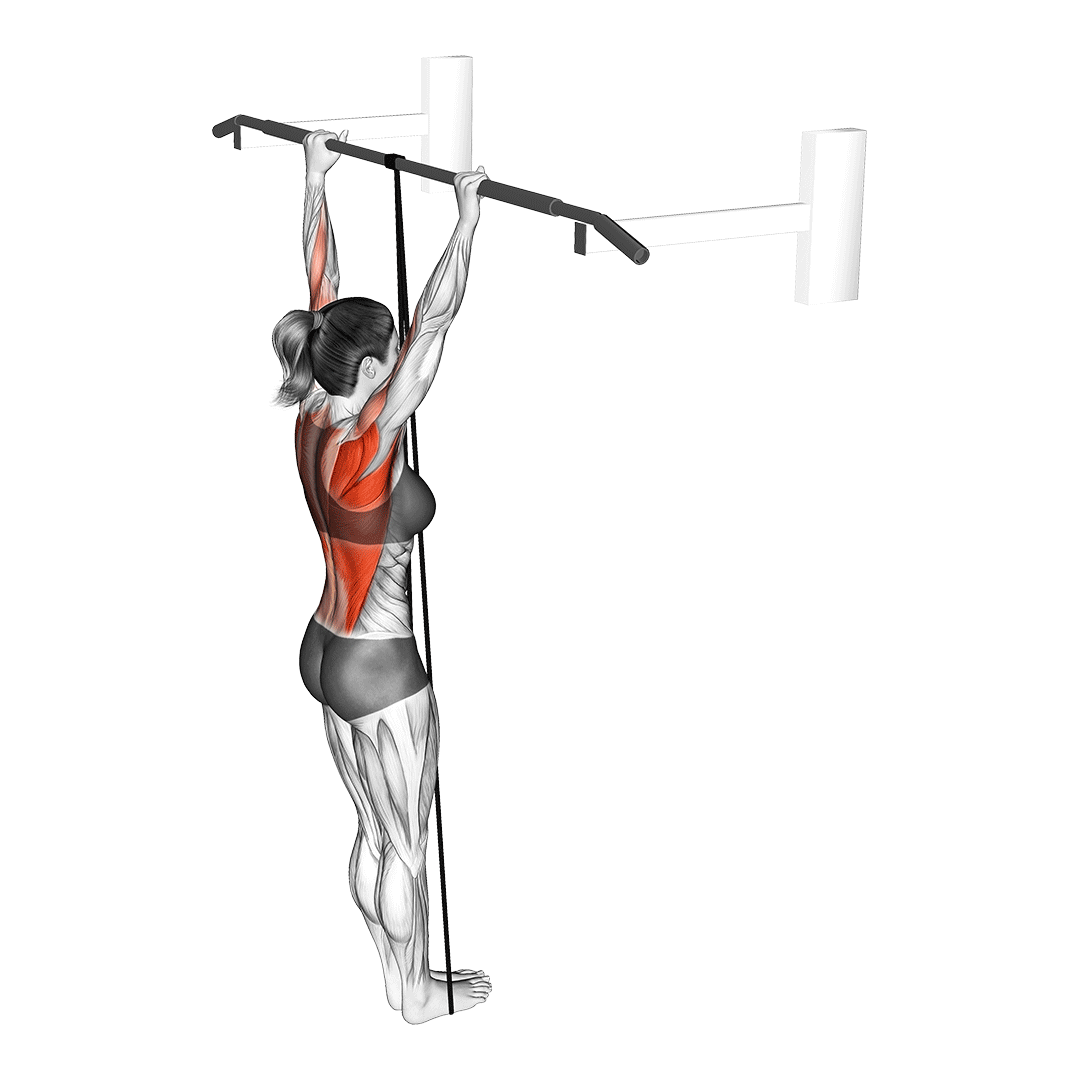
Not only do assisted pull-ups allow practice of proper form without having to lift your entire weight, but the constant resistance beneath will help you slow down the repetition - allowing for more focus on form.
Common Assisted Pull-up Mistakes to Avoid
Even with the safety and accessibility that assisted pull-ups offer, avoiding the following mistakes is vital for an injury-free and effective workout.
Using Too Much Resistance
Although the resistance of an assisted pull-up is meant to make the exercise easier, it can be tempting to get carried away and make the exercise too easy.
In order for our musculature to develop from training, a suitable level of intensity must be used. While too much can obviously result in injury, training at too low an intensity can also be a problem.
For the ideal response to training stimulus, you’ll want to keep each set of assisted pull-ups at between a 6 and a 9 on the rate of perceived exertion (RPE) scale.
Setting the Hands Too Close or Too Far Apart
During the assisted pull-up, improperly placing the hands along the bar can directly alter what muscles are worked by the exercise - as well as the rotation of the shoulders and scapula.
Ideally, you’ll want to keep your hands around shoulder-width apart, adjusting as needed for comfort.
An excessive distance between the hands may make the exercise more difficult than normal and alienate the biceps, whereas an excessively narrow one will potentially impinge the shoulders and reduce latissimus dorsi contraction.
Using Assisted Pull-Ups as a Crutch for Poor Form
Though it is true that assisted pull-ups are useful for practicing pull-up form, the reduced risk of injury should not be an excuse for poor form adherence.
Ensuring that you are performing the exercise correctly (regardless of whether it is assisted or not) is vital for not only remaining uninjured, but also for receiving any sort of benefit from your training.
If your form begins to break down due to fatigue, it is a sign that your training volume needs to be dialed back.
Insufficient Range of Motion
Achieving a full range of motion with each assisted pull-up repetition is vital to ensuring each muscle is worked correctly. This means beginning the exercise with the arms extended overhead and only beginning the descent once the bar is firmly beneath the chin.
An insufficient range of motion may cause poor development of certain muscle groups, and otherwise create a less effective exercise as a whole.
If you are unable to complete the necessary range, increasing the counter-resistance so as to make the exercise easier is perfectly fine.
Alternative Exercises to the Assisted Pull-Up
Ready to progress out of assisted pull-ups? Try out the three following exercises.
Lat Pulldowns
The lat pulldown is a machine-based back exercise mechanically similar to that of the pull-up.
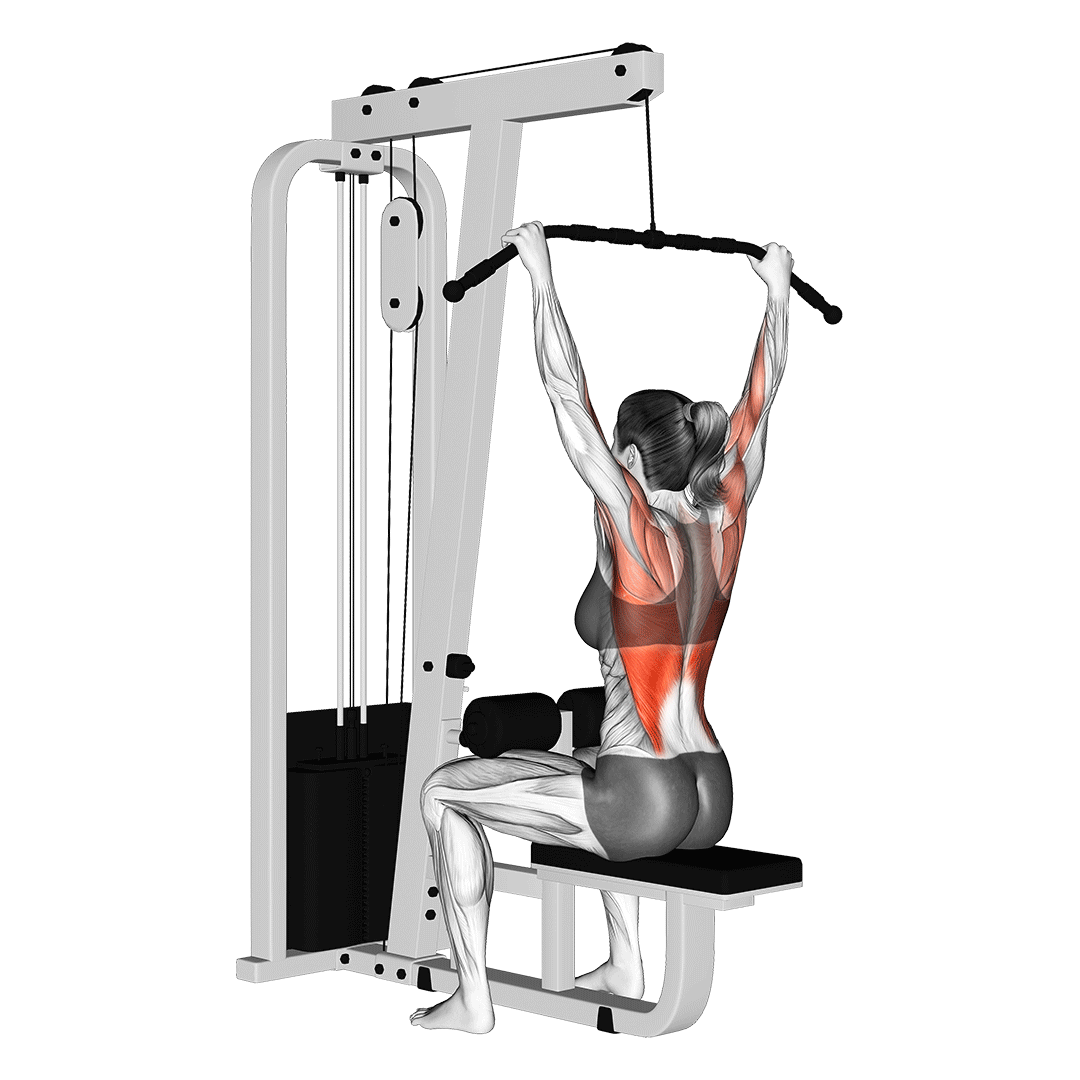
Unlike the assisted pull-up, the lat pulldown seats the exerciser in place and largely requires little to no core strength to perform. In addition, it is quite effective at emphasizing the muscles of the back in a more isolated manner.
Ideally, lat pulldowns will act as an alternative to the assisted pull-up in situations where the latter is used for back muscle training, not learning pull-up mechanics.
Negative or Eccentric Pull-Ups
For individuals that can perform pull-ups but only in low volume sets, negative pull-ups may serve as a more effective alternative to the assisted pull-up.
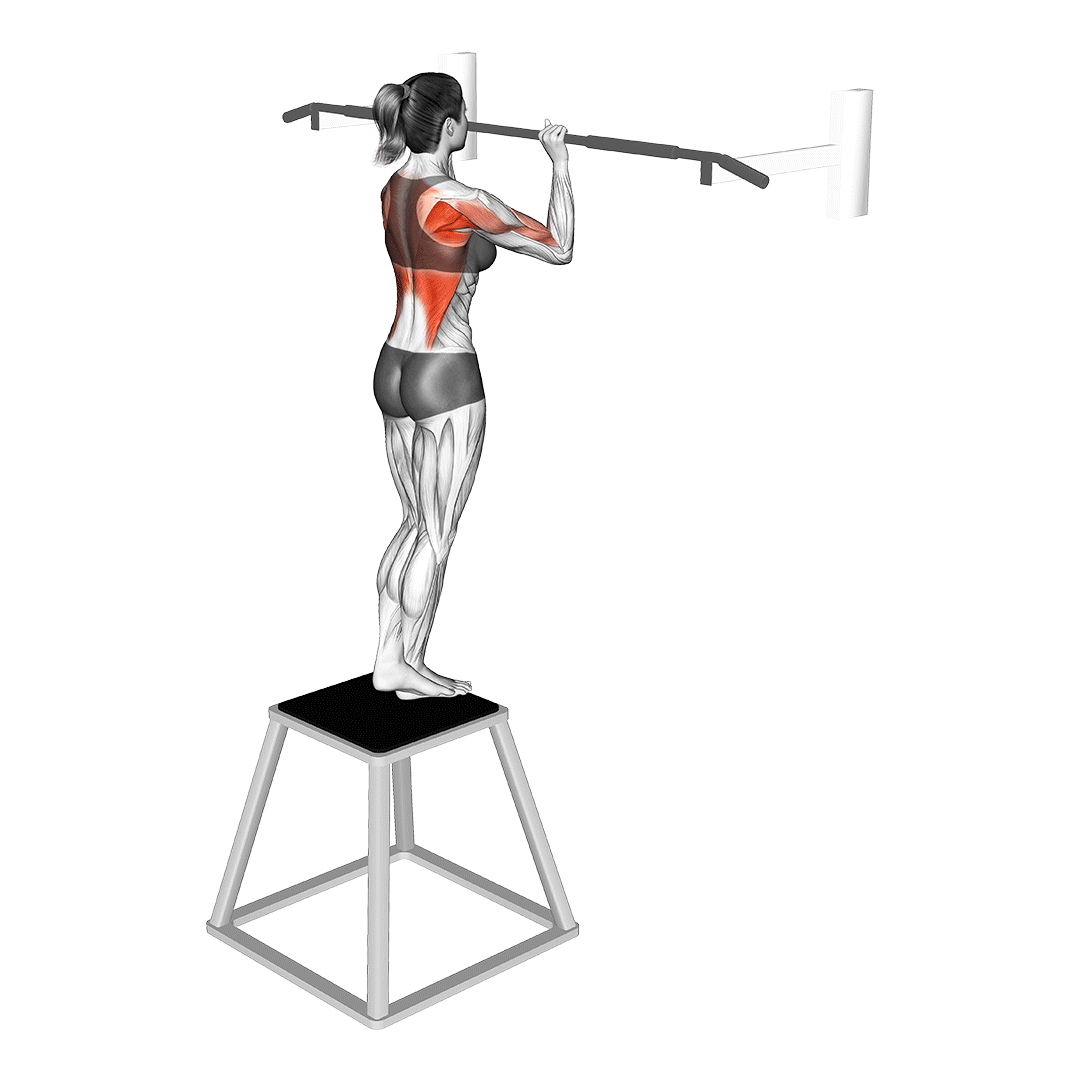
Negative pull-ups are simply conventional pull-ups performed with the descending or eccentric portion of the exercise lengthened for several seconds. This greatly increases the strength development derived from each repetition, allowing for greater pull-up strength in the future.
Unlike the assisted pull-up, the negative pull-up features no support and as such is moderately more difficult to perform as well.
Chin-Ups
Chin-ups are the more biceps-focused counterpart to the pull-up. Because the hands are turned inwards and there is a relatively shorter range of motion in play, the chin-up is also considered easier than the pull-up.

When using chin-ups as an alternative to the assisted pull-up, keep in mind that they are nonetheless far more intense than the latter exercise. Only progress from assisted pull-ups to chin-ups once you have a firm grasp of proper form, and are confident you can carry your own weight.
Frequently Asked Questions (FAQ)
How Many Assisted Pull-Ups is "Good"?
While it will depend on factors like gender, weight and training experience - generally, if you can perform 8-10 assisted pull-ups in a row, you’re ready to progress further.
Remember that this means quality repetitions. If your 8-10 pull-ups are sloppy, we advise sticking to the assisted pull-up until you’ve firmly mastered proper form.
Better safe than sorry.
Should I do Assisted Pull-Ups Everyday?
Doing any type of exercise everyday is a recipe for injury. The body requires time to heal between workout sessions, and this includes the assisted pull-up.
Instead, it is better to perform assisted pull-ups up to 3 separate times a week, with at least one day of recovery between workout sessions.
Is the Assisted Pull-Up Cheating?
Not at all.
The assisted pull-up is a necessary progression step for those who cannot do a full set of regular pull-ups.
Even in cases where you can do pull-ups, there is some merit to practicing with its assisted counterpart - or using it for greater training volume.
A Few Reminders
Regardless of whether you’re using a pull-up machine or a resistance band, remember that the entire point of the exercise is to progress further. Sticking with the assisted pull-up when your strength has far exceeded it will only slow down your development.
If you’re a novice just getting into calisthenics, seeking out the advice of a professional coach will help set you on the right track.
Additionally, if you’re planning to use the assisted pull-up machine because injuries are preventing you from doing a full pull-up, it is better to first consult a medical professional.
References
1. Schlosberg, Suzanne., Rickard, Georgia., Neporent, Liz. “Assisted Pull-Up Weight Training For Dummies.” United Kingdom: Wiley, 2011. ISBN : 9780730376620, 0730376621

